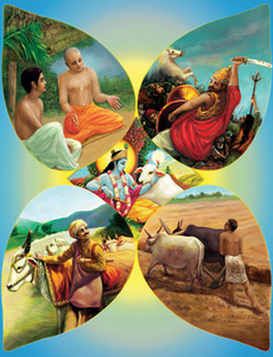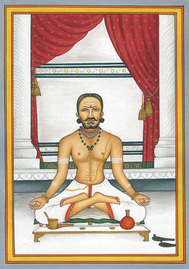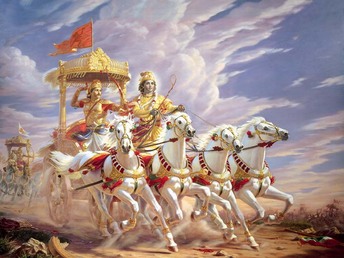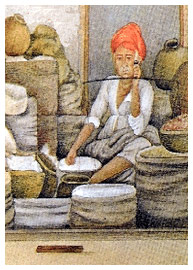| A Brief Introduction to Hinduism |
The Caste System

The Brahmin, Ksyatriya, Vaishya, and Sudra
One of the teachings of Hinduism is that of dharma, or duty. According to Karma yoga, fulfilling one's dharma is the way to achieve moksha, or salvation. Although Karma yoga is not the whole of Hinduism, it does play a large part in the religion, and thus Hinduism can be said to subscribe to a deontological ethical system. In such a system, an action's right-ness or wrong-ness is not necessarily inherent to the action; rather, the morality of an action is determined by the performer's obligations or, indeed, duties.
Hinduism couples this deontological system with its teachings on reincarnation, and these two elements put together led to the implementation of a caste system. In this societo-organizational scheme, a Hindu's deeds in previous lives determine his or her caste, or social position, in the next life. Hindus are bound to their castes by birth, and attempting to supersede or secede from one's caste is seen as a violation of dharma. After all, a Hindu's duties placed him or her in the correct caste in the first place. A caste determines one's possible jobs, marriage partners, and social standing, among other things. However, if people accept their places in life, do not complain or challenge the caste system, and humbly fulfill their duties, they may reincarnate into a higher caste system in the next life.
Right now, there is debate over the true role of the caste system in Indian society due to recent movements pushing for the abolishment of the system. This struggle creates problems for Hinduism: Is the caste system necessary for the religion? Is it just? In response to these questions, caste has changed from a personal to a political role over the past several years, as India struggles to answer these questions and maintain modern human rights' standards.
Though these are questions that Hindus must ultimately answer for themselves, it is still worthwhile to know what the main castes are, and the role each plays in Hindu and Indian society. Another point to keep in mind is that although there are four main castes, many sub- and sub-sub-castes exist as well.
Hinduism couples this deontological system with its teachings on reincarnation, and these two elements put together led to the implementation of a caste system. In this societo-organizational scheme, a Hindu's deeds in previous lives determine his or her caste, or social position, in the next life. Hindus are bound to their castes by birth, and attempting to supersede or secede from one's caste is seen as a violation of dharma. After all, a Hindu's duties placed him or her in the correct caste in the first place. A caste determines one's possible jobs, marriage partners, and social standing, among other things. However, if people accept their places in life, do not complain or challenge the caste system, and humbly fulfill their duties, they may reincarnate into a higher caste system in the next life.
Right now, there is debate over the true role of the caste system in Indian society due to recent movements pushing for the abolishment of the system. This struggle creates problems for Hinduism: Is the caste system necessary for the religion? Is it just? In response to these questions, caste has changed from a personal to a political role over the past several years, as India struggles to answer these questions and maintain modern human rights' standards.
Though these are questions that Hindus must ultimately answer for themselves, it is still worthwhile to know what the main castes are, and the role each plays in Hindu and Indian society. Another point to keep in mind is that although there are four main castes, many sub- and sub-sub-castes exist as well.
Brahmin

Brahmin are of the priestly and teacher caste. Their focus is to achieve moksha through Jnana yoga. They were also responsible for performing religious ceremonies and interpreting the Vedic texts.
Kshatriya

Kshatriya are of the warrior and ruler class. Their role is to govern and fight for India, though it has changed as political and cultural systems shift. Initially, the Kshatriya struggled with the Brahmins over the relative positions of their respective castes in society, but the Brahmins eventually came to be the highest caste. The goal of Kshatriya is to achieve moksha through Karma yoga. Pictured here is the Kshatriya Arjuna from the Bhagavad Gita as he rides into battle.
Vaishya

The Vaishya were initially responsible for planting and harvesting food through agriculture, but their role eventually shifted to that of a merchant caste. Possible Vaishya careers include those of farmer, artisans (carpenter, shoe-maker, etc.), and salesman. Vaishya were to achieve moksha through Bhakti yoga, though by following Karma yoga they could move up the caste system to become a Kshatriya in the next life. As Vaishya came to resent the low position given them by the Brahmin, they began to support alternative practices, such as Buddhism, as time went on. Mahâtmâ Gandhi, one of the most famous Hindus, was of the Vaishya cast, though he was exiled from it as he began his human rights' campaigns.
Sudra/Dalit

The Sudra are the lowest caste in Hinduism; they are often called "untouchables" or "outcastes" (though to do so is now considered politically incorrect). Sudra worked as laborers; jobs included cleaning up after dead animals, tanning animal hides, and dealing with human/animal waste. The best hope of moksha for Sudra was Bhakti yoga.
The position of the Sudra is what causes much of the conflict regarding the caste system, as Sudra are heavily mistreated. Mahâtmâ Gandhi spent much of his life campaigning for the rights of the Sudra.
Sometimes the Sudra are conceptually joined with the true "untouchables," or those who do not have a place within the caste system.
The position of the Sudra is what causes much of the conflict regarding the caste system, as Sudra are heavily mistreated. Mahâtmâ Gandhi spent much of his life campaigning for the rights of the Sudra.
Sometimes the Sudra are conceptually joined with the true "untouchables," or those who do not have a place within the caste system.
Sources:
http://krishna.org/the-horrible-indian-caste-system/
http://asianhistory.about.com/od/india/p/indiancastesystem.htm
http://www.friesian.com/caste.htm
http://teabagsfortwopoems.blogspot.com/2010/09/colliding-cultures-aryans-and.html
http://themanagmentguru.blogspot.com/2010/06/mahabharata-new-age-managers.html
http://www.indiancultureonline.com/details/Vaishya.html
http://www.amnh.org/exhibitions/diamonds/caste.html
http://krishna.org/the-horrible-indian-caste-system/
http://asianhistory.about.com/od/india/p/indiancastesystem.htm
http://www.friesian.com/caste.htm
http://teabagsfortwopoems.blogspot.com/2010/09/colliding-cultures-aryans-and.html
http://themanagmentguru.blogspot.com/2010/06/mahabharata-new-age-managers.html
http://www.indiancultureonline.com/details/Vaishya.html
http://www.amnh.org/exhibitions/diamonds/caste.html
